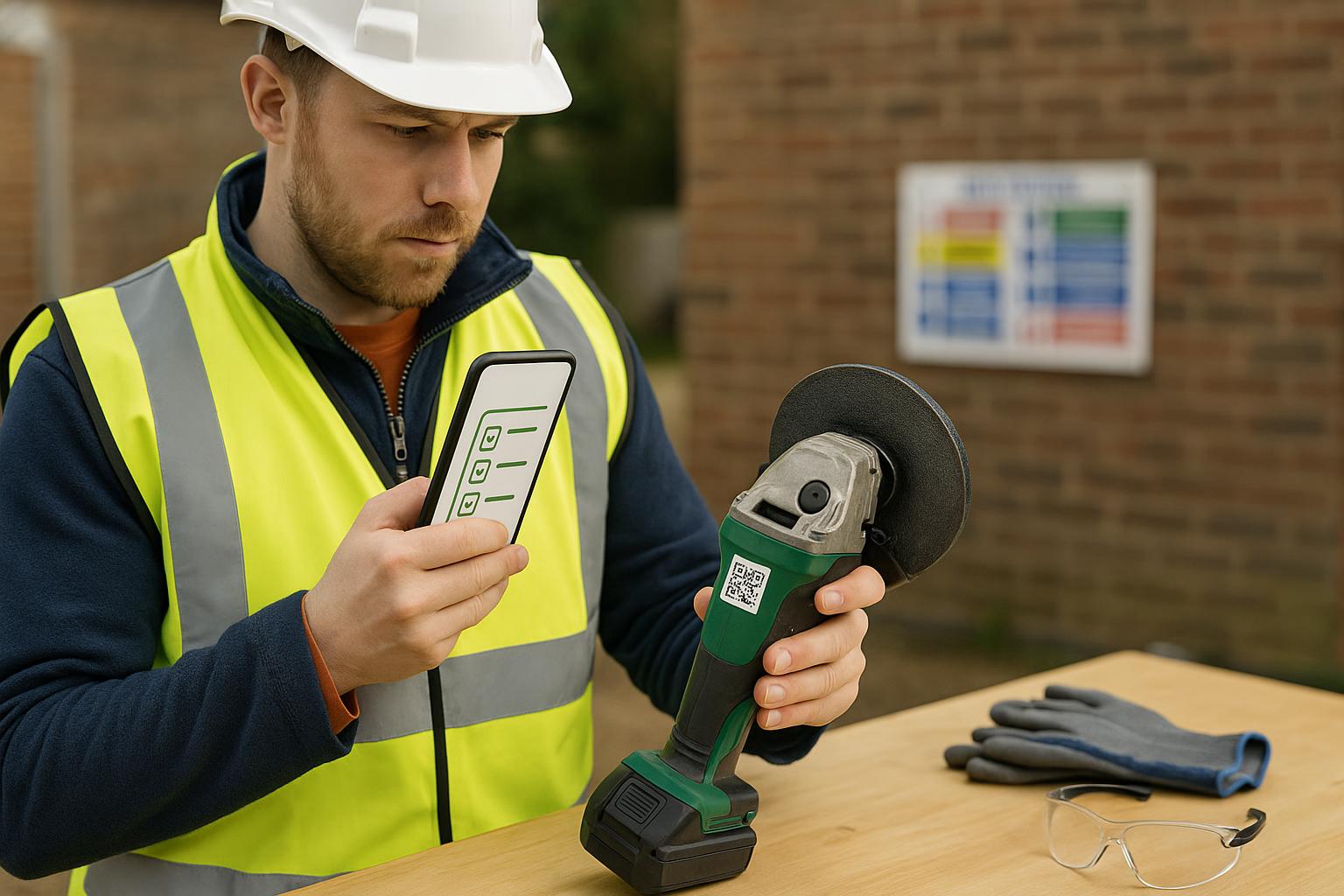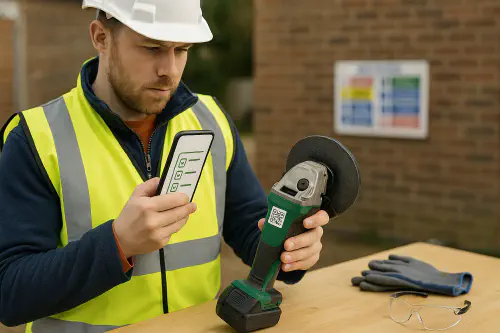
Power tool pre‑use checks and PUWER: simple daily checklist, QR logging and when to record inspections
Power tool pre‑use checks and PUWER: simple daily checklist, QR logging and when to record inspections
Category: Templates & Resources • Niche: PUWER, power tools, daily checks, QR/NFC logging, small crews
Contents
- Quick answer
- What PUWER actually requires
- Daily pre‑use checks (copy this)
- When you must record an inspection
- Fast QR/NFC logging setup (Google Sheets/AppSheet)
- Simple maintenance and PAT plan
- Downloadable one‑pager checklist
- FAQs

Engineer scanning a QR label on an angle grinder to log a pre‑use check
Quick answer
- You must keep work equipment safe and maintained (PUWER Reg 5) and inspect it where there’s a risk from incorrect installation or deterioration (PUWER Reg 6).
- For most hand‑held power tools, a brief pre‑use check by the user is enough day‑to‑day; you only need a recorded inspection at risk‑based intervals or after something changes (damage, re‑assembly, unusual conditions).
- Recordkeeping: keep Reg 6 inspection records at least until the next one; provide physical evidence if equipment leaves your control (eg a tag/record). Pre‑use checks don’t normally need to be recorded.
Useful references: HSE – Inspection of work equipment, HSE – PUWER overview, HSG107 – Maintaining portable electrical equipment, HSG17 – Abrasive wheels.
What PUWER actually requires
- Maintenance vs inspection
- Reg 5: keep tools in an efficient state, in efficient working order and in good repair. Keep any maintenance log up to date if one exists.
- Reg 6: inspect when safety depends on installation, at suitable intervals to detect deterioration, and after exceptional circumstances (eg damage, major modification, change of location). Inspections must be by a competent person. Keep the result until the next inspection.
- What needs inspecting
- Anything where incorrect installation or deterioration could create risk. Focus on safety‑critical parts: guards, interlocks, triggers, stops, cables/batteries, plugs, hoses. Frequency is set by your risk assessment and manufacturer guidance.
- When equipment leaves/enters your control
- Send physical evidence of the last inspection with it (a label, report or tag). This is especially relevant for hired/loaned kit.
Sources: HSE – Inspection of work equipment and the Provision and Use of Work Equipment Regulations 1998.
Daily pre‑use checks (copy this)
Do this at start of shift or before first use. If anything fails, remove the tool from service and label it clearly.
- Corded tools (drills, grinders, saws)
- Casing and handle sound; trigger/lock‑off works; guards in place and set.
- Cable and plug free of cuts, crushed sections or exposed conductors; strain relief intact.
- Correct accessory fitted and rated for the RPM; no cracks or missing teeth. Test RCD if used.
- Battery tools
- Battery locks in place; no swelling, cracks or leaks; charger and leads undamaged.
- As above for the tool body, trigger and guards.
- Abrasive wheels (angle/bench grinders, cut‑off saws)
- Guard fitted and adjusted; flanges/blotters present; wheel undamaged and speed‑rated; spindle nut secure.
- Bench grinder tool rest set close to wheel; perform ring test where applicable. See HSG17.
- Pneumatic tools
- Hoses/couplings undamaged and clipped; trigger/guard functional; air pressure appropriate; no abnormal noise or vibration.
Tip: Keep a small “Do Not Use” tag pack in the van so defects don’t drift back into service.
When you must record an inspection
- After installation or re‑assembly where safety depends on it (eg a fixed bench grinder moved and re‑bolted).
- At suitable intervals based on risk and manufacturer guidance (eg quarterly for high‑use grinders on dusty sites; longer for low‑use items kept in clean storage).
- After exceptional events: damage, major modification, or harsh conditions (immersion, heavy impact).
- What to record (good practice): equipment ID/location, date/time, inspector, scope, defects, actions taken, next due date. Electronic records are fine if secure and available on request. Keep until the next inspection.
Source: HSE – Inspection of work equipment.
Fast QR/NFC logging setup (Google Sheets/AppSheet)
Aim: one‑tap condition logs and photo evidence without buying new software.
- Data backbone
- Google Sheet with columns: Asset_ID, Tool_Name, Status, Last_Check, Condition, Photo_URL, Location, Notes.
- Build a simple AppSheet app over the Sheet. Enable offline + delayed sync for patchy sites.
- Scan flows
- QR: Print a QR label that links to a pre‑filled Google Form for that asset (so Asset_ID auto‑fills). User scans, ticks condition, snaps a photo, submits.
- NFC: Write the same link to an NFC tag (on‑metal NTAG213 for metal tools). Android opens the Form/AppSheet link instantly when tapped; iOS can read NDEF tags too.
- Tags that last
- Use durable labels from UK suppliers like Brady; for NFC, pick IP‑rated, on‑metal discs. Position tags where they won’t be abraded.
- Automations
- Email/Slack a manager when “Damaged” is selected.
- Weekly digest of missed checks by tool or crew.
Helpful links: AppSheet offline and sync, AppSheet NFC scanning, HSG107 electrical maintenance, Brady UK labels.
Simple maintenance and PAT plan
- Follow the manufacturer schedule plus a sensible site plan from HSG107:
- User checks: each use/day.
- Formal visual inspections: set a frequency by risk (eg monthly or quarterly for high‑use tools).
- Combined inspection and testing (PAT): only where risk justifies it. You can extend intervals if the environment is low risk and your records show good history.
- Keep batteries, chargers and cords clean and dry; store tools in closed boxes to reduce dust ingress and damage.
Downloadable one‑pager checklist
Copy/paste this into your job system or print it for vans.
Tool ID: ______ Location: ______ Date/Time: ______ Checked by: ______
- Body/guarding OK [ ] Trigger/lock‑off OK [ ] Cable/plug/battery OK [ ]
- Accessory/wheel OK, speed‑rated [ ] RCD tested (if used) [ ]
- Abnormal noise/vibration [ ] None [ ] Investigate
- Notes/actions: ______________________ Remove from service: [ ]
Store completed sheets in your Google Drive “PUWER” folder, or log via the QR/NFC method above.
FAQs
- Do I have to PAT test every quarter?
- No. HSE recommends a risk‑based approach. Many portable tools only need user checks and occasional inspection/testing. See HSG107.
- Do pre‑use checks need a record?
- Normally no. Reg 6 records are for formal inspections at set intervals or after events. Pre‑use checks are quick safety checks.
- Who is a “competent person” for inspections?
- Someone with the right knowledge/experience for the tool and the inspection needed. For complex kit, use a competent technician.
- If I lend a tool to another firm, what should go with it?
- Physical evidence of the last inspection (eg a tag or copy of the record).
- Angle grinder wheels: what’s the main failure you see on site?
- Cracked or wrong‑rated discs. Always check the speed rating and use guards. See HSG17.
Call‑to‑action
Want to slash training times and increase revenue per Engineer? Join our Waitlist: https://trainar.ai/waitlist